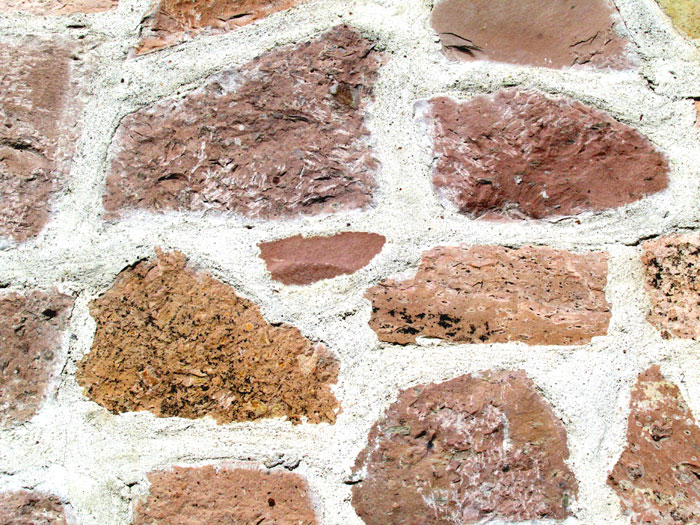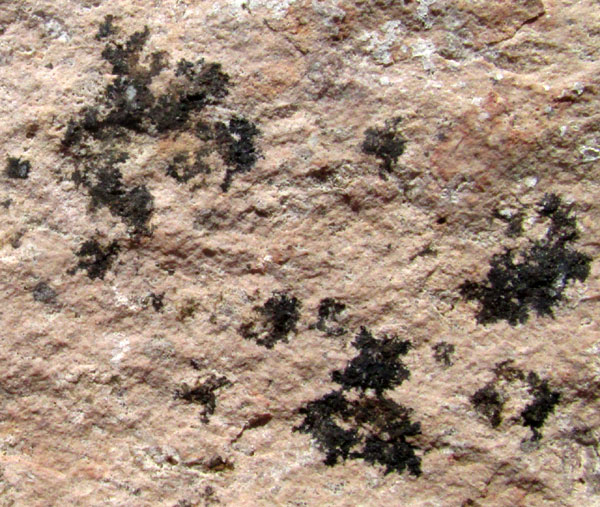Excerpts from Jim Conrad's
Naturalist Newsletter
entry dated June 1, 2022, issued from near Tequisquiapan, elevation about 1,900m (6200 ft), ~N20.57°, ~ W99.89°, Querétaro state, MÉXICO
RHYOLITE

In this area much building is done with quarried rocks composed mostly of the volcanic rock called rhyolite. A section of rhyolite stone wall is shown above. The local rocks usually are pinkish in color, but that's not true of rhyolite in many areas. In general the main thing said of rhyolite rock color is that it's a light hue, due to its low content of dark colored minerals.
The hills around here are composed mostly of rhyolite, and when you see them it's hard to keep from thinking about the volcanic processes forming the rock. Volcanic rocks are classified as either intrusive or extrusive. Intrusive volcanic rocks are formed when molten magma from deep within the Earth surges upward, but fails to be erupted. It remains inside the earth where it cools into rock. Such intrusive rock might be found in a volcanic pipe where it almost erupted, but stopped short of being ejected. Often magma spreads sideways underground, maybe between strata near the surface, forming features such as sills, dikes, laccoliths and stocks.
But rhyolite is extrusive, so it's formed of magma that's been erupted outside the volcano, as lava. Chemically, rhyolite is the same as granite, with both rock types containing a lot of silica, SiO2. It's just that granite is intrusive, while rhyolite is extrusive. What causes the difference between rhyolite and granite is that the magma from which granite was formed, remaining inside the earth, cools slower than the lava ejected onto the landscape. The slower that either magma or lava cools, the more time minerals have to concentrate and form crystals. The slower the cooling, the larger the crystals grow. In granite, it's easy to see the crystals, but in rhyolite rock any crystals that form normally are so small they can't be seen without magnification.
In the above picture, notice that each rock, though rhyolite, looks a little different from every other rock. That's because lava erupted from a volcano at one time and place may differ from lava erupted nearby at a different time and/or different place. Rhyolite-forming lava may vary greatly, depending on its particular assemblage of minerals, gasses and water, on whether it's mixed with other material on the Earth's surface, whether when cooling it experiences different pressure from above than other parts of the flow, etc.

Some of our local rhyolite rocks have black specks in them, which usually are flecks of the black, silica-rich rock called obsidian. I think the above close-up shows specks of obsidian during the early stages of "devitrification." Obsidian is basically black glass that over geological time is unstable and breaks down. When black obsidian flecks completely disintegrate, they form white "snowflake obsidian," which may form irregularly shaped patches of white, such as that which appears on some rocks in the top picture.

Both rhyolite and granite contain plenty of quartz, and sometimes, as above, veins of white quartz or the white, quartz-rich mineral zeolite appear.
Rhyolite-forming lava is thick and slow moving, sometimes cooling so slowly that the resulting rock displays the former lava's flowing action -- "flow banding" -- as shown below:

Our rhyolite hills also get us to thinking about the volcanoes which erupted the lava that cooled into the rhyolite. The 2007 edition of the Mexican Geological Service (SGM) Geological Mining Map of the Tequisquiapan Quadrangle, F14-C67, indicates that our local rhyolite outcroppings were erupted from volcanoes about 3 million years ago during the Pliocene Epoch of the Neogene Period. During that time, the western mountains of North America and Mexico were rising, attended by much volcanic activity. The land was populated by mastodons, saber-tooth tigers, sloths, llamas and other large, now extinct mammals. Also, in Africa, there were close-to-human primates of the genus Australopithecus, from whom the human genus Homo someday would emerge.